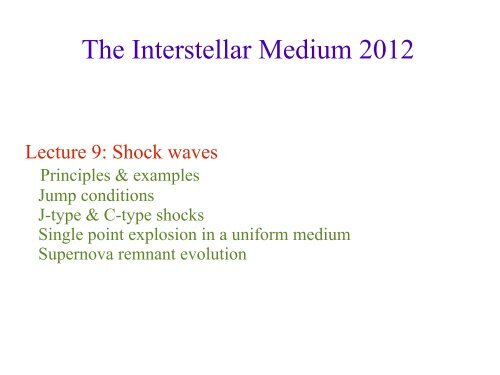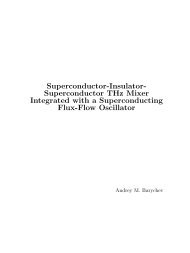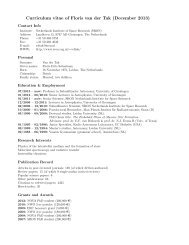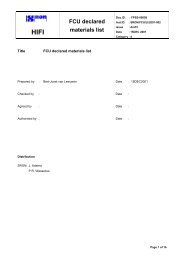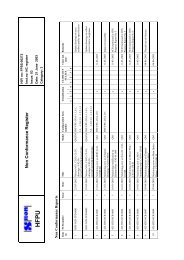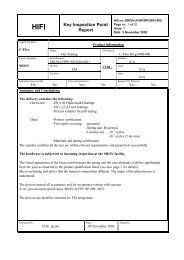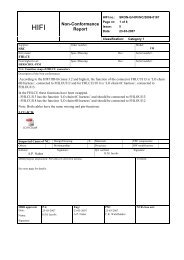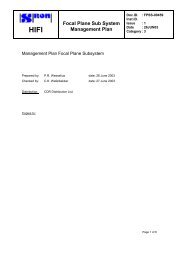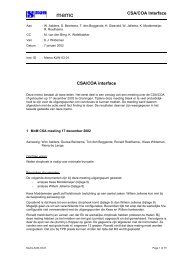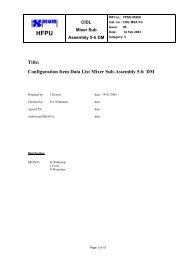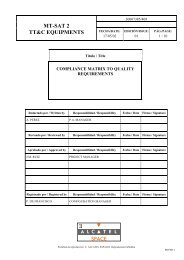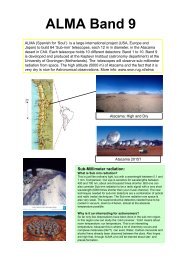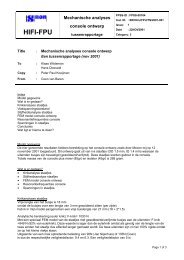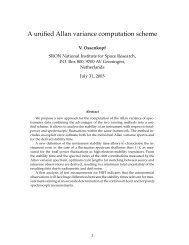Interstellar shock waves - SRON
Interstellar shock waves - SRON
Interstellar shock waves - SRON
You also want an ePaper? Increase the reach of your titles
YUMPU automatically turns print PDFs into web optimized ePapers that Google loves.
The <strong>Interstellar</strong> Medium 2012<br />
Lecture 9: Shock <strong>waves</strong><br />
Principles & examples<br />
Jump conditions<br />
J-type & C-type <strong>shock</strong>s<br />
Single point explosion in a uniform medium<br />
Supernova remnant evolution
Date Topic Book chapter<br />
24-04-2012 Overview of the ISM 1, 12, 40<br />
Part 1: Regions of ionized gas<br />
26-04-2012 Pure hydrogen nebulae 3, 4, 10, 11<br />
03-05-2012 Nebulae with heavier elements 6, 14 (+ 14.3), 15 (+ 15.8)<br />
04-05-2012 Heating & cooling of H + regions 2, 27<br />
08-05-2012 Diagnostics of H + regions 17, 18 (+18.4), 28<br />
10-05-2012 Non-stellar H + regions 13, 16, 20 (+20.2, 20.3)<br />
Part 2: Regions of neutral gas<br />
15-05-2012 Observational probes of neutral gas 8, 9, 29<br />
22-05-2012 Thermal balance of neutral gas 30<br />
24-05-2012 <strong>Interstellar</strong> <strong>shock</strong> <strong>waves</strong> 35, 36 (+36.6)<br />
29-05-2012 The multi-phase ISM 34, 39<br />
Part 3: Regions of molecular gas<br />
31-05-2012 Molecular spectra 5, 7, 19, 31<br />
05-06-2012 <strong>Interstellar</strong> dust 21, 22, 23, 24, 25<br />
06-06-2012 Diffuse molecular clouds & PDRs 32, 33<br />
12-06-2012 Dense molecular clouds & star formation 41, 42<br />
14-06-2012 The extragalactic ISM<br />
19-06-2012 exam (room 5113.0201)
Lecture 8: Heating and cooling of atomic gas<br />
Heating mechanisms<br />
p.i. carbon; p.e. dust & PAH; cosmic rays; X-rays<br />
Cooling mechanisms<br />
C + 158 μm; other fine structure lines; Lyα<br />
Thermal balance & the two-phase ISM<br />
multiple solutions co-exist in pressure equilibrium<br />
Large-scale distribution of atomic gas<br />
maps: flare & warp; tangent point; l-V diagram; rotation curve<br />
Small scale features<br />
21 cm ≈ 100 μm ≈ Α V<br />
; HVCs as local DLA analogs
Homework: Draine Chapters 35, 36<br />
Fluid dynamics<br />
conservation of mass, momentum, energy<br />
relevant forces: pressure, EM, gravity, viscosity<br />
isobaric / isochoric cooling; cooling time; flux freezing<br />
Shock <strong>waves</strong><br />
many astrophysical occasions<br />
jump conditions<br />
magnetosonic speed, Mach number<br />
magnetic precursor, C-type, J-type <strong>shock</strong>s
The <strong>Interstellar</strong> Medium 2012<br />
Lecture 9: Shock <strong>waves</strong><br />
Principles & examples<br />
Jump conditions<br />
J-type & C-type <strong>shock</strong>s<br />
Single point explosion in a uniform medium<br />
Supernova remnant evolution
Shock <strong>waves</strong><br />
Shock: pressure-driven compressive disturbance<br />
traveling faster than the local signal speed<br />
Produces an irreversible change in the state of the fluid<br />
Literature:<br />
Landau & Lifschitz, Fluid Mechanics, chapter IV<br />
Dyson & Williams 1997, Chapters 6 & 7
Sound speed and Mach number<br />
Sound speed: c S<br />
2<br />
= dP / dρ<br />
Take EoS P = Kρ γ<br />
γ = 5/3 for adiabatic fluid<br />
γ = 1 for isothermal fluid<br />
Adiabatic flow: c S<br />
∼ ρ 1/3<br />
sound speed is larger in denser gas<br />
For isothermal gas in ISM<br />
c S<br />
= (kT/m) 0.5 ≈ 1 km/s (very small!)<br />
Mach number: M = V / c S
Steepening of non-linear acoustic wave<br />
Speed is larger in dense gas<br />
wave crest travels faster than trough<br />
crest catches up with troughs<br />
waveform steepens<br />
steepening halted by viscous forces<br />
development of a <strong>shock</strong>
Signal speeds in the ISM<br />
In the absence of magnetic fields, information travels at<br />
the sound speed<br />
M < 1: subsonic<br />
M > 1: supersonic → <strong>shock</strong>s<br />
If magnetic field present, disturbances travel along the<br />
field lines at the Alfvén speed<br />
<strong>Interstellar</strong> field strengths: empirical law<br />
B = 1 μG √n H<br />
for 10 < n H<br />
< 10 6 cm -3
Example 1: Cloud-cloud collisions<br />
v 0<br />
= 5 – 10 km/s; v S<br />
≈ v 0
Example 2: Expansion of an H + region<br />
(only one phase in the evolution of an H + region)
Example 3: Fast stellar wind
Speeds of stellar winds
Example 4: Supernova blast wave
Example 5: Star formation – infall & outflow
Example 6: Spiral <strong>shock</strong>s in Galactic disk
The <strong>Interstellar</strong> Medium 2012<br />
Lecture 9: Shock <strong>waves</strong><br />
Principles & examples<br />
Jump conditions<br />
J-type & C-type <strong>shock</strong>s<br />
Single point explosion in a uniform medium<br />
Supernova remnant evolution
Jump conditions for <strong>shock</strong>s<br />
Adopt reference frame where <strong>shock</strong> is stationary<br />
Consider plane-parallel <strong>shock</strong><br />
conditions depend only on distance x from front<br />
Neglect viscosity, except in transition zone:<br />
large velocity gradient<br />
viscous dissipation<br />
transform bulk kinetic energy into heat<br />
irreversible change: entropy increases
Velocity & temperature profiles (in <strong>shock</strong> frame)
More jump conditions<br />
Thickness of <strong>shock</strong> front ≤ mean free path of particles<br />
always
Mass conservation<br />
General case:<br />
For a steady plane-parallel <strong>shock</strong>:<br />
→<br />
Integrate across the <strong>shock</strong>:
Momentum conservation<br />
or using<br />
which re-writes into<br />
and assuming no change in the gravitational potential Φ
Energy conservation<br />
(heat conduction / heating / cooling)<br />
U = internal energy per unit volume = P / (γ-1)<br />
Same procedure as before:<br />
which is ≈0 if 1 and 2 are close
Magnetic field<br />
The electric field vanishes in the fluid frame<br />
The Maxwell equation then reduces to<br />
(flux freezing / field decay)<br />
The last term describes diffusion of the magnetic field<br />
vanishes if the conductivity σ → ∞ (ideal MHD)
Often-used simplifying assumptions<br />
Planar <strong>shock</strong>: v y<br />
= v z<br />
= 0<br />
No heat conduction: κ ∇T = 0<br />
No net heating or cooling: ∫ 1<br />
2<br />
(Γ −Λ) = 0<br />
No gravitational force: ∫ 1<br />
2<br />
ρv x<br />
Φ dx = 0<br />
Internal energy density U = P / (γ-1) with γ = c P<br />
/ c V<br />
Magnetic field perpendicular to flow: B x<br />
= 0<br />
may choose B y<br />
= 0<br />
Ideal MHD: ∂/∂x (v x<br />
B y<br />
−v y<br />
B x<br />
) = ∂/∂x (v z<br />
B x<br />
−v x<br />
B z<br />
) = 0
The Rankine – Hugoniot equations<br />
Follow general practice<br />
write v x<br />
= u 1<br />
(= v S<br />
)<br />
Mass conservation:<br />
ρ 1<br />
u 1<br />
= ρ 2<br />
u 2<br />
Momentum conservation:<br />
Energy conservation:<br />
Flux conservation:<br />
u 1<br />
B 1<br />
= u 2<br />
B 2
William<br />
Rankine<br />
1820 – 1872
Solving the Rankine – Hugoniot equations<br />
The jump conditions are 4 equations in 4 unknowns:<br />
ρ 2<br />
, u 2<br />
, P 2<br />
, B 2<br />
Define x = u 1<br />
/ u 2<br />
= ρ 2<br />
/ ρ 1<br />
= B 2<br />
/ B 1<br />
Now we have two equations in P 2<br />
and x:<br />
and<br />
Define “magnetic” Mach number:<br />
where
Solving the Rankine – Hugoniot equations (2)<br />
The trivial solution 1 = 2 always exists<br />
A second solution exists for M > 1<br />
Strong <strong>shock</strong> (M >> 1):<br />
= 4 for γ = 5/3<br />
and<br />
For γ = 5/3, 2 (γ−1) / (γ+1) 2 = 3/16, so
Properties of strong <strong>shock</strong>s<br />
The compression ratio x = 4<br />
If 16 B 1<br />
2<br />
/ 8ρ
Radiative vs adiabatic <strong>shock</strong>s<br />
So far considered <strong>shock</strong>s without radiative cooling<br />
“adiabatic <strong>shock</strong>s”<br />
Bad terminology: <strong>shock</strong>s are abrupt and irreversible<br />
Adiabatic means here: no heat is removed<br />
If post<strong>shock</strong> gas radiates line emission<br />
cools down in “radiative <strong>shock</strong>”<br />
If temperature in region 3 is same as in region 1:<br />
“isothermal <strong>shock</strong>”<br />
Bad terminology again:<br />
temperature always rises at <strong>shock</strong> front
Structure of “isothermal” <strong>shock</strong>s<br />
Solve jump conditions with T 3<br />
= T 1<br />
:<br />
ρ 3<br />
>> ρ 1<br />
If B = 0: ρ 3<br />
/ ρ 1<br />
= M 2<br />
compression factor can be >> 4<br />
If B > 0:<br />
where B 1<br />
= b√n 1<br />
x 10 -6 G<br />
Typical compression factors x ≈ 100
The <strong>Interstellar</strong> Medium 2012<br />
Lecture 9: Shock <strong>waves</strong><br />
Principles & examples<br />
Jump conditions<br />
J-type & C-type <strong>shock</strong>s<br />
Single point explosion in a uniform medium<br />
Supernova remnant evolution
J-type and C-type <strong>shock</strong>s<br />
So far only considered single-fluid <strong>shock</strong>s<br />
aka J-type <strong>shock</strong>s<br />
Generally, ISM gas consists of 3 fluids<br />
neutrals<br />
ions<br />
electrons<br />
which can develop different temperatures and velocities<br />
For B > 0, information travels by MHD <strong>waves</strong><br />
Perpendicular to B, the propagation speed is
Magnetic precursors<br />
Since v A<br />
∼ √ρ the Alfvén speed for decoupled ionelectron<br />
plasma can be much larger than if coupled<br />
In many cases: c S<br />
< v A,n<br />
< v S<br />
< v A,ie<br />
The ion-electron plasma sends information ahead of the<br />
disturbance and “informs” the pre-<strong>shock</strong> plasma that the<br />
compression is coming: magnetic precursor<br />
The compression is now subsonic and the transition<br />
smooth and continuous: C-type <strong>shock</strong><br />
The ions then couple to the neutrals by collisions
Comparing J- and C-<strong>shock</strong>s<br />
J-type (“jump”) <strong>shock</strong>s: v S<br />
> 50 km/s<br />
<strong>shock</strong> abrupt<br />
neutrals and ions tied into one fluid<br />
warm: T = 40 v S<br />
2<br />
[K; v in km s -1 ]<br />
most radiation in ultraviolet<br />
C-type (“continuous”) <strong>shock</strong>s: v S<br />
< 50 km/s<br />
gas variables (T, ρ, v) change gradually<br />
ions ahead of neutrals; drag modifies neutral flow<br />
T i<br />
≈ T n<br />
; both much lower than in J-<strong>shock</strong>s<br />
most radiation in infrared
Structure of J- and C-<strong>shock</strong>s
C-<strong>shock</strong> structure: Draine & Katz 1986
J-<strong>shock</strong> structure: Hollenbach & McKee 1989<br />
Three regions:<br />
hot, UV emission<br />
warm, Lyα absorption<br />
cold, molecule formation<br />
Weak gas-grain coupling:<br />
T d<br />
The <strong>Interstellar</strong> Medium 2012<br />
Lecture 9: Shock <strong>waves</strong><br />
Principles & examples<br />
Jump conditions<br />
J-type & C-type <strong>shock</strong>s<br />
Single point explosion in a uniform medium<br />
Supernova remnant evolution
Single-point explosion<br />
Idealized treatment due to Sedov (1959) and Taylor<br />
See also Chevalier (1974)<br />
Equally applicable to atomic bombs<br />
Assumptions:<br />
one-fluid treatment adequate (mean free path
Self-similar solution<br />
Characteristic quantities:<br />
explosion energy E<br />
ambient density ρ 0<br />
time since explosion t<br />
Evolution of ρ, v and T is described by universal<br />
functions of only one dimensionless parameter<br />
v (R,t) = (R / t) f v<br />
(r/R)<br />
ρ (R,t) = ρ 0<br />
f ρ<br />
(r/R)<br />
T (R,t) = (mv 2 / k) f T<br />
(r/R)
Dimensional analysis<br />
Find dependence of R(t) on E, ρ 0<br />
and t by writing<br />
R(t) = A t α E β ρ 0<br />
γ<br />
Mass: 0 = 0 + β + γ<br />
Length: 1 = 0 + 2β − 3γ<br />
Time: 0 = α − 2β + 0<br />
Result: α = 2/5, β = 1/5, γ = −1/5<br />
R(t) = A (E t 2 / ρ 0<br />
) 1/5 ∼ t 2/5
The numerical constant A<br />
To estimate value of A, consider<br />
expect A ~ 1<br />
adiabatic case: E tot<br />
= E kin<br />
+ E th<br />
= constant<br />
self-similar: E kin<br />
/ E th<br />
= constant<br />
Right behind <strong>shock</strong> (v = ¾ v S<br />
):
Detailed calculation of A<br />
Assume most mass located just behind <strong>shock</strong><br />
OK from detailed solution<br />
E kin<br />
~ E th<br />
for entire SNR<br />
E kin<br />
= ½ M v S<br />
2<br />
with M = (4π/3) R 3 ρ 0<br />
Then:<br />
E 0<br />
= 2E kin<br />
= (4π/3) R 3 ρ 0<br />
v S<br />
2<br />
Writing R = C t α we have v S<br />
= α C t α −1<br />
Then E 0<br />
= (4π/3) ρ 0<br />
C 5 α 2 t 5α−2 = constant, so α = 2/5<br />
C 5 = (3/4π) (5/2) 2 (E 0<br />
/ρ 0<br />
)<br />
C = 1.083 (E 0<br />
/ρ 0<br />
) 1/5 so A = 1.083<br />
Exact solution for γ = 5/3: A = 1.15169
Sedov solution<br />
50% of mass in outer 6% of radius<br />
T ∼ P / ρ drops from center to edge
The <strong>Interstellar</strong> Medium 2012<br />
Lecture 9: Shock <strong>waves</strong><br />
Principles & examples<br />
Jump conditions<br />
J-type & C-type <strong>shock</strong>s<br />
Single point explosion in a uniform medium<br />
Supernova remnant evolution
Evolution of supernova remnants<br />
Four phases:<br />
Early phase: M swept<br />
M ejecta<br />
and t < t cool<br />
Radiative phase: t ~ t cool<br />
Merging phase: v S<br />
< ΔV ISM
The early phase<br />
Condition: M swept<br />
The Sedov phase<br />
Condition: M swept<br />
> M ejecta<br />
but t < t rad<br />
Pressure-driven expansion:<br />
cooling inefficient as long as v S<br />
> 250 km/s<br />
full ionization at T ≈ 10 6 K<br />
Self-similar solution:<br />
R = 1.15167 (E 0<br />
t 2 / ρ 0<br />
) 1/5 ; v S<br />
= 2R / 5t<br />
Numerical calculation:
Cooling at end of Sedov phase
The end of the Sedov phase<br />
To estimate t rad<br />
note that<br />
most cooling occurs just behind <strong>shock</strong><br />
high ρ, low T<br />
Cooling rate:<br />
Half of E thermal<br />
is radiated when:<br />
Note that <strong>shock</strong> velocity almost constant
The radiative phase<br />
Cold dense shell slows down<br />
by sweeping up ambient ISM<br />
momentum is conserved<br />
Naive snowplow: neglect P i<br />
d(Mv) / dt = 0 → M v ∼ M cool<br />
v cool<br />
R 3 v = R 3 cool v cool → v ∼ R-3<br />
v ∼ R / t → R ∼ t 1/4
The Oort snowplow<br />
Include P i<br />
:<br />
d(Mv) / dt = P i<br />
4πR 2<br />
P i<br />
drops due to adiabatic expansion:<br />
P i<br />
= P cool<br />
(R / R cool<br />
) -3γ<br />
Together, using γ = 5/3:<br />
So we have:<br />
R = R cool<br />
(t / t cool<br />
) 2/7<br />
v S<br />
= v S, cool<br />
(t / t cool<br />
) -5/7
The merging phase<br />
The SNR fades away when<br />
expansion velocity ≈ velocity dispersion ambient gas<br />
Using the Oort snowplow:<br />
So we have:
Summary of supernova remnant evolution<br />
Early phase<br />
M swept<br />
M ejecta<br />
& t < t rad<br />
energy conservation: R ∼ t 2/5<br />
Radiative “snowplow” phase<br />
t > t rad<br />
momentum conservation: R ∼ t 1/4 or R ∼ t 2/7<br />
Merging phase<br />
v S<br />
drops below ΔV of ambient ISM
Overview of supernova remnant evolution<br />
200 yr 3 x 10 4 yr 3 x 10 5 yr
Leonid Ivanovitch Sedov 1907 – 1999<br />
Devised similarity solution for<br />
blast <strong>waves</strong><br />
First chairman of USSR space<br />
exploration program<br />
President of the International<br />
Astronautical Federation<br />
Played leading role in Sputnik<br />
project


